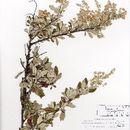Comprehensive Description
(
Anglèis
)
fornì da North American Flora
Sericotheca argentea (ly. f.) Rydberg
spiraea argentea L. f. Suppl. 261. 1781.
Holodiscus argenteus Maxim. Acta Hort. Petrop. 6 : 254. 1879. Schizonotus argenteus Kuntze, Rev. Gen. 225. 1891. Schizonotus argenteus Mutisianus Kuntze, Rev. Gen. 226. 1891.
A tall shrub ; bark of the young twigs gray and densely tomentose, strongly angled ; that of the old stems dark-gray ; leaf-blades oblanceolate, 1-3 cm. long, thick, white-silky on both sides, acute at the apex, cuneate at the base and decurrent on the short petioles ; inflorescence compound, ovoid, 4-8 cm. long, with ascending tomentose branches ; sepals triangular-ovate, acute, about 1.5 mm. long; petals obovate, about 2 mm, long; stamens 20, shorter than the sepals ; carpels obliquely obovate, curved on the upper edge but less so than on the lower, their bodies about 2 mm. long, their beaks 1 mm.
J
Type locality : New Grenada.
Distribution : Mountains of Colombia ; also reported from Costa Rica, perhaps doubtful.
- sitassion bibliogràfica
- Frederick Vernon Coville, Nathaniel Lord Britton, Henry Allan Gleason, John Kunkel Small, Charles Louis Pollard, Per Axel Rydberg. 1908. GROSSULARIACEAE, PLATANACEAE, CROSSOSOMATACEAE, CONNARACEAE, CALYCANTHACEAE, and ROSACEAE (pars). North American flora. vol 22(3). New York Botanical Garden, New York, NY
Comprehensive Description
(
Anglèis
)
fornì da North American Flora
Sericotheca schaffneri Rydberg, sp. nov
spiraea discolor dumosa S. Wats. Proc. Am. Acad. 17: 353. 1882. } Schizonotus argenteus griseus Kuntze, Rev. Gen. 226. 1891.
A low shrub ; bark of young twigs dark-brown, finely villous, that of the older branches almost black, exfoliating ; petioles 3-5 mm. long ; leaf-blades 1-3 cm. long, ovate or roundedoval, obtuse at the apex, usually somewhat cuneate at the base and slightly decurrent on the petioles, more or less doubly serrate with ovate, mucronate teeth, sparingly pubescent on both sides, only slightly paler (not at all tomentose) and conspicuously glandular-atomiferous beneath; inflorescence ovate, 5-7 cm. long, about 5 cm. wide, branched but branches usually simple, ascending-spreading; sepals ovate, acute, 1.5-1.75 mm. long; petals elliptic or oval, about 2 mm. long; stamens 15-20, about 2 mm. long;pistils 5; carpels semi-obovate, nearly 2 mm. long, with beaks scarcely 1 mm. long.
Type collected at San I.uis Potosi, Mexico, in 1879, W. S chaff ner 451 (herb. N. Y. Bot. Card.). Distribution : Northern Mexico and Arizona.
- sitassion bibliogràfica
- Frederick Vernon Coville, Nathaniel Lord Britton, Henry Allan Gleason, John Kunkel Small, Charles Louis Pollard, Per Axel Rydberg. 1908. GROSSULARIACEAE, PLATANACEAE, CROSSOSOMATACEAE, CONNARACEAE, CALYCANTHACEAE, and ROSACEAE (pars). North American flora. vol 22(3). New York Botanical Garden, New York, NY

